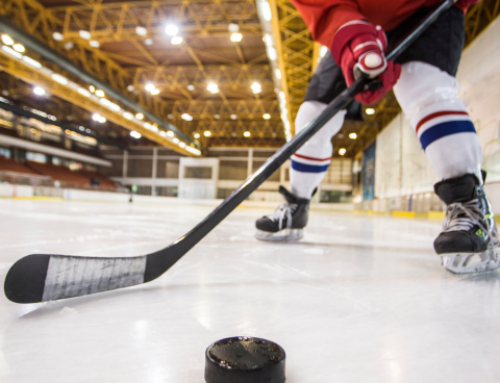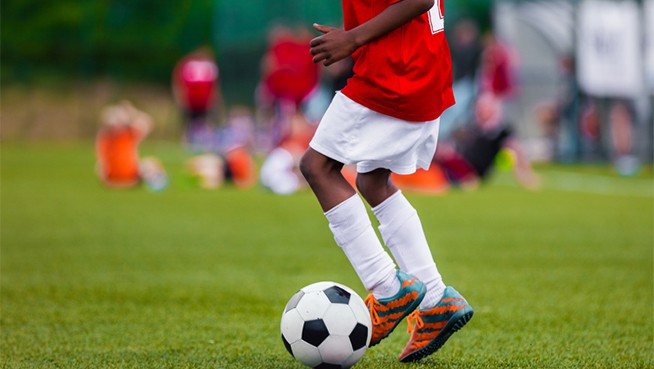Hockey Players: Increase Your Skating Speed with These Starting Tips
To increase your skating speed, you’ve got to master your start. The faster you accelerate at the start, the more potential you create for top-end speed, and the easier it becomes to reach your top skating speed.
There are three types of starts in hockey, two forward and one backward. Below are some tips to help improve the mechanics of your starts:
Forward Crossover Starts
- Stay in a low position from the hips down with a deep-knee bend and your skates shoulder-width apart.
- Drive off the outside and inside skate with a crossover motion, bringing your skates to a “V” position.
- Finish the start with two running steps from the V position.
- Internally rotate your head and body in the direction you want to go.
- Load 100 percent of your body weight on each thrusting skate.
Forward Explosive Starts (V-Start)
- Skates start in V position.
- Keep your weight on the balls of your feet. Form a diamond pattern with your legs.
- Drive starts from mid-blade through the ball of the foot on the inside edges. Skates stay low to the ice.
- Take three or four explosive strides directly back on the inside edges, exploding through the hips, knees and ankles to full extension.
- Momentum and force are directed forward, not up.
Common Errors with Forward Starts
- Driving upward, not forward, with the torso.
- Incomplete return of recovery leg underneath body.
- Lacking full extension of the leg.
Explosive Backward Starts
- Stay low in a powerful position from the hips down and a deep knee bend.
- Equal maximum thrusts from both legs generating speed.
- Backward crossovers are an acceleration tool, not a replacement for backwards stride.
Errors to avoid:
- Too shallow a C cut
- Uneven weight distribution
With proper start mechanics in place, players can shift their focus to the two main components of elite skating speed: reaction time and explosiveness. Although it is instinctive for many players, reaction time is often referred to as “hockey sense.” As in any sport, if you are able to anticipate where the play is going, you have an advantage over your opponent, since you are already headed in the right direction.
Read more:
RECOMMENDED FOR YOU
MOST POPULAR
Hockey Players: Increase Your Skating Speed with These Starting Tips
To increase your skating speed, you’ve got to master your start. The faster you accelerate at the start, the more potential you create for top-end speed, and the easier it becomes to reach your top skating speed.
There are three types of starts in hockey, two forward and one backward. Below are some tips to help improve the mechanics of your starts:
Forward Crossover Starts
- Stay in a low position from the hips down with a deep-knee bend and your skates shoulder-width apart.
- Drive off the outside and inside skate with a crossover motion, bringing your skates to a “V” position.
- Finish the start with two running steps from the V position.
- Internally rotate your head and body in the direction you want to go.
- Load 100 percent of your body weight on each thrusting skate.
Forward Explosive Starts (V-Start)
- Skates start in V position.
- Keep your weight on the balls of your feet. Form a diamond pattern with your legs.
- Drive starts from mid-blade through the ball of the foot on the inside edges. Skates stay low to the ice.
- Take three or four explosive strides directly back on the inside edges, exploding through the hips, knees and ankles to full extension.
- Momentum and force are directed forward, not up.
Common Errors with Forward Starts
- Driving upward, not forward, with the torso.
- Incomplete return of recovery leg underneath body.
- Lacking full extension of the leg.
Explosive Backward Starts
- Stay low in a powerful position from the hips down and a deep knee bend.
- Equal maximum thrusts from both legs generating speed.
- Backward crossovers are an acceleration tool, not a replacement for backwards stride.
Errors to avoid:
- Too shallow a C cut
- Uneven weight distribution
With proper start mechanics in place, players can shift their focus to the two main components of elite skating speed: reaction time and explosiveness. Although it is instinctive for many players, reaction time is often referred to as “hockey sense.” As in any sport, if you are able to anticipate where the play is going, you have an advantage over your opponent, since you are already headed in the right direction.
Read more:










